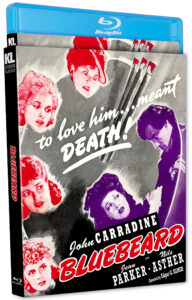John Carradine is the Maiden-Murdering Marionette Master Stalking Paris!
DIRECTED BY EDGAR G. ULMER/1944
BLU-RAY STREET DATE: APRIL 30, 2024/KL STUDIO CLASSICS

Too talky and proper for the monster-driven 1940s horror movie marathons but too warped and wild-eyed for polite moviegoing company, 1944’s Bluebeard is positively discombobulated. Set in gaslit Paris of pre-Eiffel Tower times, the compact (at only seventy-two minutes) John Carradine vehicle appropriates the seventeenth century French legend of Barbe bleue, the upper-class wife killer, as does the in-world public warnings posted early in the movie by gendarmes’. “Warning! Citizens of Paris! A murderer is in your midst! A criminal who strangled young women! Any person having information concerning this Bluebeard please communicate with the police at once!”
Directed with imperfectly crooked panache by German expat turned Hollywood exile Edgar G. Ulmer (1934’s The Black Cat; 1945’s Detour) proves to be a downright déconcerté work. Said by Ulmer to have been a six-day shoot, scheduled by PRC to be a twelve-day shoot, but ultimately a nineteen-day shoot (all according to film historian Gregory W. Mank’s new audio commentary track), Bluebeard is a biting black and white beast in fancy clothing. At glance it reads as the costume thriller it often is, though at its core toils Ulmer’s unsettled vision of the material.
Ulmer busies up every frame of Bluebeard with subtly invasive detail, allowing the frilly layers and layers of the women’s dresses to compete with the art-packed walls and decor run amok. It lacks the composed artistry of Josef Von Sternberg’s controlled clutter aesthetic, leaning instead to that of an overcompensating madman against the clock. Depending upon whom one consults, that’s exactly what Ulmer was at this time. Here, in distinct portions, leans hard into canted 1920s German expressionism, his shot choices momentarily extreme in both their composition and editing. Not all said flourishes land, though in such moments, Bluebeard is effectively rescued from being a talky bore.

An ironically clean-shaven John Carradine occupies a wealth of Bluebeard, commanding the screen in what is often said to be his very finest of his 273 film roles. He plays gentlemanly strangler Gaston Morrell, a tortured artist who’s past painting of women inevitably has led him doing them in. Keen to stop killing, Morrell has switched to marionette street performances. In Act I, the movie stops cold for one such musical “puppet show” (as he calls them). Admiring of the performance is Lucille (Jean Parker), who, to the chagrin of her thinly veiled female lovers (!), strikes up a potentially romantic relationship with Morrell.
Not one but two new film historian-hosted commentaries appear on the KL Studio Classics disc. The first is the aforementioned track with Gregory W. Mank, with cut-in remote assists by fellow “monster kid” Tom Weaver. Both provide plenty of contextualized information about Bluebeard, Carradine, and Ulmer. Mank amusingly describes smalltime PRC Studios as perpetrators of “midnight horror devil freak flicks.” As for the always affable Weaver, he does speak an awful lot about himself and his own tumultuous relationship with the film, but doggonit, you come away having learned a lot.

The second commentary is with the incomparable David Del Valle, who immediately sets his track apart stating that he was friends with Carradine and a neighbor of Ulmer’s widow, Shirley. So, beyond even the interview due diligence done by Mark and Weaver years ago, Del Valle brings a personal flourish. He speaks about what this rare starring role meant to Carradine, and why Ulmer was compelled to give the actor such a fine showcase. It is made clear that even amid its imposed shortcomings in time and resources, Bluebeard is, from top to bottom, purely Ulmer.
Clearly, Ulmer’s Bluebeard has its enthusiasts. Though KL’s “80th Anniversary Edition” Blu-ray of this hastily formally attired public domain outlier utilizes a 4K scan of an HD master carried by Paramount Pictures in 2020, it still appears rather rough in many portions. Yet, according to both commentaries, it previously always looked far, far worse. So, classic film buffs, be grateful for what we’ve got here. It may not be pretty, but it sure is well dressed.

